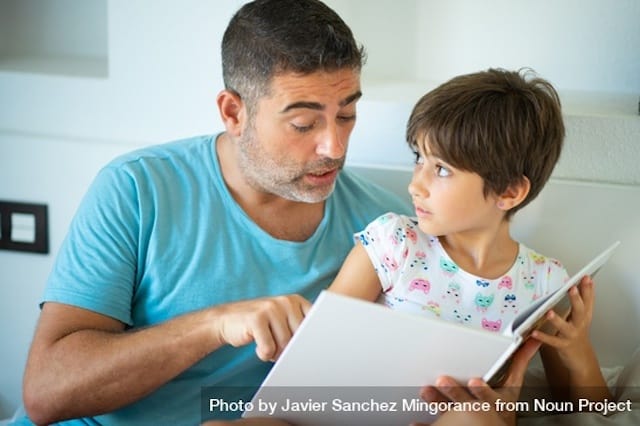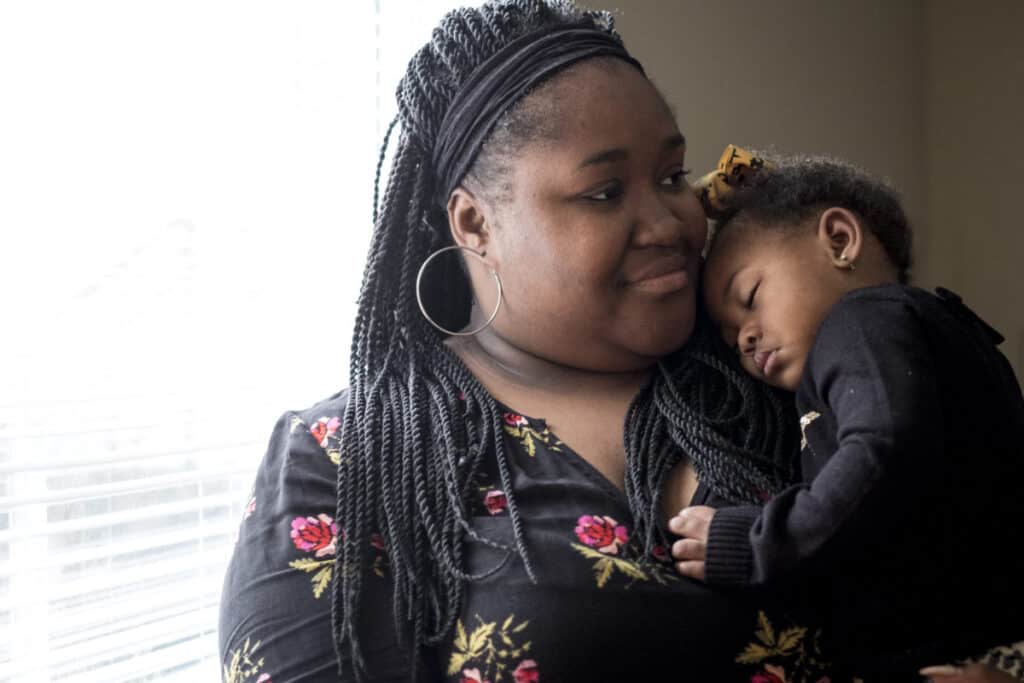If your child is having a hard time with reading, there are strategies that can help! Maybe you’re just starting to be concerned about your child’s learning. Or maybe they already have an IEP but the reading instruction is ramping up and causing new struggles. Either way, we’ll explain how to work together with the school to come up with a plan to help your child. We’ll also describe some ways you can help at home.
Remember that the school should have the same goals as you: they want students to learn, make progress, and be happy and confident.
What to do at school if your child is having a hard time reading
Talk to the teacher about literacy
The first steps are to think about why you are concerned and talk with your child’s teacher.
Think about what your child is having trouble with:
- Reading fluency…Vocabulary…Comprehension…Writing?
- Focusing on their work: do they get distracted too often?
- Social or emotional challenges: do they get upset often and have trouble managing emotions or social interactions?
Struggling with reading can be because of a learning disability like dyslexia. But it can also be a more general problem like a developmental disability or trouble focusing. Read more about why your child may be struggling.
Questions to ask:
- In what areas is my child struggling?
- What do the assessments show?
- Are they reading at grade level?
- What does the instruction look like? What do they do in class?
- What kind of instruction works well for my child?
- What is the teacher doing to adjust the instruction?
- What other strategies can the teacher try?
The big question is: what can the school do to help your child learn literacy skills in ways that may be more effective?
If your child is not getting special education services, explore the reasons they are struggling and see if the school can work on some general interventions to help them learn.
Remember you are an equal partner and have rights. You have a right to make sure that your child is educated, that the school identifies any disabilities that your child may have, and that the school provides specialized services if your child has a learning or developmental disability.
If your child already has an IEP, you may want to look at it again and see if it includes the right supports for learning to read. Literacy is a complex set of skills and can be hard for many students in the early grades.
Look at your child’s school assessments
The regular assessments they do in school should help the teacher know where your child needs more help. Ask about these assessments and make sure you understand what they say about your child’s progress. Keep checking on them every couple weeks.
There are different kinds, but the Curriculum-Based Assessments are the immediate snapshots of how your child is doing with the lessons in their class at any given time. The teacher will do these from week to week and can tell if a child is not keeping up. These snapshots are the ones to ask about regularly.
Include literacy goals and services in the IEP
If your child has a literacy-related learning disability like dyslexia, here are some tips to create effective IEP goals and supports.
When you set up the meeting:
Make sure there is a reading specialist in the IEP meeting. Ideally this would be one of the people who did the evaluation.
Ask about this when you first schedule the IEP meeting. There should be someone in the district who can play this role.
When you’re in the meeting:
Ask for specifics about your child’s reading disability. What literacy components do they struggle with? How will that affect other components, like comprehension or writing?
- Make sure the goals address all the components your child needs help with
Ask what instructional (teaching) methods they suggest. For example, the Orton Gillingham method is a proven teaching strategy for kids with dyslexia. Your state policy may not specify a specific method, but it probably specifies that it should be “multisensory”. This means it includes different senses: seeing text, hearing sounds, and physically moving cards or blocks into the right order.
- Ask if there is research to show these methods work (“Is this an evidence-based intervention?” “Is it data-driven?” “Is it a multisensory approach?”)
Make sure the goals are specific, clear, and measurable.
Look at examples of IEP Goals for Reading, Fluency, and Decoding.
The IEP is not only about reading skills. Ask if your child needs any other kind of support. They may need help with fine motor coordination that affects writing. Or they may have social or emotional needs that affect their confidence in the school setting.
Learn more about setting up an IEP
- More about the IEP
- Family Checklist: Getting ready for an IEP meeting
- Glossary of terms and acronyms
Ask questions at the IEP meeting about reading and literacy
Remember you have the right to ask any questions before the IEP meeting or during it. Here are some questions you may want to ask:
When you schedule the IEP meeting:
- [If English is not your preferred language] Will there be an interpreter there? I know this is my legal right
- Will there be a reading specialist at the meeting? I want to be sure we all understand how my child’s disability affects reading skills
- Will at least one of the evaluators be there? I want to make sure I understand the evaluation report
- Please send me the evaluation report and the draft of the IEP before the meeting
At the meeting:
- What grade level is my child reading at now?
- What does the report show, exactly? What specific challenges are affecting my child’s reading?
- What kind of interventions or instructional strategies do you suggest? Are they “evidence-based” (or “data-driven”)? Do they use a “multisensory approach”?
- How many times per week will my child get specialized reading instruction? Is that enough to help my child aim for catching up to grade-level skills?
- Are there any accommodations that will help my child in the classroom? (Extra time for tests, frequent breaks, assistive technology, or other supports)
- Does my child need help with anything else, like speech and language, fine motor skills, or social and emotional regulation?
- Is there consultation time included in the IEP so the classroom teachers working with my child can get support in the teaching techniques?
- How will you monitor progress? What assessments will you do, and how often?
- Is all of this written into the IEP?
What to do at home if your child is having a hard time reading
While much of your child’s reading instruction happens in school, there is a lot that happens at home too! Your reading habits with your child can make a big difference.
Read! Read! Read! The most important thing you can do is read to your child and read with your child.
The more a child interacts with books, the better! It also helps to talk with your child as much as possible. This helps with vocabulary and background knowledge, which helps with reading skills.
Read and talk a lot at home:
- Have books in the house
- Read to your child
- Find books that your child is interested in – explore the library
- Read together with your child: take turns or have them read to you
- Connect the spoken words to the words on the page
- Ask them questions about what they read
- Talk and read about the topics they’re learning about in school
- Listen to audiobooks at home or while you drive
- Make it fun! Be loving, silly, and cozy as you read and explore books together!
Improving their background knowledge of a topic will help your child’s reading skills. For example, if they’re learning about sea creatures, watch documentaries and read books about whales and sharks and the sea. Go to an aquarium if possible. Talk about what they see and read. They will get more familiar with the facts and learn more vocabulary. This will help when they read about it in school!
Work with the teacher to learn how to practice at home:
The next step is to work with your child’s teacher to find out what aspects of reading your child struggles with, and use some specific strategies to practice those skills.
Find out what your child needs to work on most. Then ask the teacher for strategies to use at home to practice these skills.
Follow along with what your child is learning in school. Talk to them about the topics in their ELA lessons and supervise their homework when you can. (ELA is English Language Arts, which is literacy.)
Questions to ask:
- Is my child struggling with fluency, comprehension, or other components of literacy? What skills do they need to work on?
- What is my child’s independent reading level? (This can help you pick the right books to read at home)
- Is my child reading grade-level texts in class? (If not, ask what support the teacher is giving your child to help them build up to this)
- How are you measuring reading progress? How often should I expect updates? (Ask them to look at your child’s assessments with you)
- What topics are you covering in class? (You can talk to your child about the topics to improve background knowledge and vocabulary)
- How can I help my child at home?
How to practice specific literacy skills
There are specific strategies to help with different kinds of literacy challenges. Learn which strategies can help practice the components of literacy that your child struggles with most. Remember that all components are needed, and they all work together. Each one will help students develop the others.
These are some examples of strategies you can try at home. For each, make sure that you are working with text at the right reading level. Ask your child’s teacher what level they should be using. The teacher can also suggest books and other strategies.
Phonics and decoding
There are a lot of ways to practice phonics and decoding.
How you practice depends on what your child already knows and what sounds they are having trouble with. Younger children may need help with the letter sounds. Or they may need help with combinations of letters like “th”, “sh”, “br” “oo”, “ou” “oi”, etc.
There are many ways to practice, but you should find out your child’s level and what they are working on in school. Ask your child’s teacher what is the best way to help, based on this.
Here are some general ways to practice:
- Listen to your child read out loud
- Read aloud with them so they hear you sound out words
- Follow the words with your finger as they or you read
- Note the kinds of words they have trouble sounding out and practice these
- Practice pairing sounds with letters (or groups of letters) using nonsense words
- Break apart words into syllables and have them match the words back together
Learn more about phonics and decoding.
Vocabulary
The best way to build vocabulary is to read a lot of books!
Talking about different topics also helps. Expose your child to as much language as possible and teach new words as they come up.
- Talk about the meaning of new words as your child sees them in books or hears them in conversation
- Have your child read several different books or articles about the same topic. This helps them build a vocabulary about this topic. You can also watch tv shows and documentaries or listen to books about the topic. It all helps them build their knowledge and vocabulary
- Read books to your child that are a little above their own reading level. Talk about new words and practice using them in conversation
- Connect new words to similar ones they know. Talk about their opposites. (“Joyful” is like “happy”. What’s the opposite? Yes, “sad”!) Children’s brains are always making connections to things they know. This is how they learn
- Practice new words in conversation. Prompt your child to use ones you’ve just learned (“I’m feeling happy today. How else can I say that?”)
Fluency
Remember that fluent reading is accurate, flows at a good rate (not too fast, not too slow), and includes proper expression.
The best way to practice is to read with your child and model a good fluent reading style. They can learn from how you use your voice.
These are some specific techniques to help with fluency:
- Choral Reading: Reading together with your child. You both read the words out loud at the same time
- Echo Reading: You read a sentence out loud and then they read the same one out loud
- See this video about choral and echo reading
- Here’s another video of a mom reading with her child
Writing
Writing practice is very specific to what level and skills they are working on in class. It’s more complicated than practicing reading.
How you help your child at home depends on what they are struggling with, and on what skills they are expected to be learning. It could be grammar and sentence structure, or using more varied words in their writing. It could be identifying a main theme, organizing an essay or providing more specific evidence to support their argument.
The best thing to do is talk to their teacher and ask for specific ways to practice what they need.
Reading practice can be fun!
Be playful and enjoy this special time with your child. Cozy up with a blanket, read outside on a bench, or make it into a game and pick small rewards for doing a good job. If your child is fidgety, let them use a fidget while you read. Or build in some activity, like 10 jumping jacks after each book or chapter. If you make it into a nice time to spend together, it will help your child think of reading as fun, not work.
Keep an eye on how stressed they seem or how much they are struggling. You will know that the level is too high when your child loses interest or starts to get frustrated, so to build up their skills, keep it at their level and keep it engaging.
Parents can do a lot to help if a child has a hard time reading. Start early and keep at it. It matters!
Learn more:
- Resources for children struggling with reading (Includes some resources specific to Louisiana, but most are for everyone)
- Blogs about reading and literacy
- How can RTI (Response to Intervention) help if my child struggles in school?
- Learning Heroes Website: get tips and activities to help your child practice skills at their grade level
- Reading Rockets: resources to help struggling readers
********************
LA:
LEAP 2025 Assessments:
- LEAP = The Louisiana Educational Assessment Program
- They are standardized tests given every Spring to all Louisiana students in grades 3-12
If you want to see the kinds of things that the school expects students to know in different grades, see the LEAP 2025 Practice Tests. (Scroll down to Practice Tests and pick your child’s grade and the subject you want to see.)
********************



